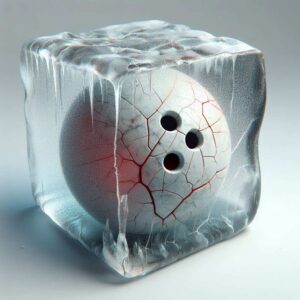Bowling may seem like a simple game of rolling a ball down a lane to knock over pins, but serious bowlers know it requires precise mechanics and strong physical skills. Mastering the bowling approach, timing, release, and other techniques is essential for striking consistently.
Just like with any sport, bowlers need to train not just their bowling skills but their overall fitness too. A bowling workout regimen boosts strength, flexibility, balance, and stamina which all translate to better performance. This prevents injury and fatigue while enabling a smooth, powerful, and accurate bowling motion.
In this article, we provide 11 effective exercises bowlers can incorporate into their training routines to improve their bowling skills, technique, and fitness for the lane.
-
Wrist Curls
Wrist curls are a simple yet effective exercise for building bowling-specific forearm and wrist strength. As you swing the ball back, then forward towards the release, your wrist flexors and extensors control the proper orientation of your hand and fingers. Strong wrists allow you to grip and control the bowling ball with authority through the entire approach and swing.
To perform wrist curls:
- Sit down and place your forearm on your thigh with your wrist and hand extended just past your knee.
- Hold a light dumbbell or wrist weight in your hand, palm facing upward. Start with a 3-5 lb weight.
- Slowly curl your wrist upwards towards you, going through the full range of motion. Focus on activating the forearm muscles.
- Slowly lower back to the starting position.
- Complete 2-3 sets of 15 repetitions on each wrist.
Over time gradually increase weight to further strengthen your wrists and forearms. You can also do reverse wrist curls with your palm facing downwards to work the opposite forearm muscles.
-
Hand Squeezes
A strong grip is vital for controlling the bowling ball during the swing and release. Hand squeezes develop finger, hand, and forearm strength for applying an even grip and lift on the ball.
Try these different types of hand squeezes:
- Tennis ball squeezes – Squeeze a tennis ball as hard as you can, holding for 5 seconds. Complete 15-20 reps.
- Towel twists – Twist a towel using both hands in opposite directions. Repeat for 15-20 seconds.
- Finger curls – Use fingers to lift a dumbbell off a table, holding briefly. Do 12-15 reps per hand.
- Plate pinches – Grip a weight plate between your fingers and thumb. Lift your hand upwards while pinching the plate.
Perform these hand exercises 2-3 times per week to build grip strength. This translates to better bowling ball control.
-
Shoulder Rotations
Having flexible, strong rotator cuff and shoulder muscles enables a full backswing and follow-through when bowling. Poor shoulder mobility and stability lead to an abbreviated swing, costing you pin-smashing power.
Rotator cuff exercises improve shoulder flexibility and strength. Try performing these moves:
- Forward arm circles – Stand with arms extended out to the sides. Make small continuous circles forward, progressing to bigger circles.
- Backward arm circles – Perform arm circles in the reverse direction, backward.
- Shoulder external rotations – Hold arms firmly at sides. Rotate one arm outward, keeping the elbow pinned. Return and switch arms.
- Shoulder internal rotations – Same as above, but rotate the arm across the body.
Aim for 10-15 reps on each arm, 2-3 sets per direction. Over time, incorporate lightweight dumbbells or resistance bands to increase difficulty.
-
Planks
Planks build incredible core strength and stability through the midsection. In bowling, core strength enables you to smoothly transfer power from your legs and hips upward through the torso, shoulders, and arms. Effective energy transfer is key for maximizing ball speed.
To perform a standard plank:
- Get into a press-up position, resting your forearms on the ground. Engage your core.
- Keep your back flat and your legs extended behind you. Contract your glutes and abs.
- Hold the plank position for 20-60 seconds, or as long as you can with proper form. Repeat for 2-3 sets.
For added difficulty, perform side planks by balancing on one forearm with your body sideways. Planks build endurance in the core muscles used heavily in the bowling approach.
-
Squats and Lunges
A powerful leg drive is essential during the second step of the bowling approach. Squats and lunges build lower body strength to help you explode into the release with force and balance.
When squatting:
- Stand with feet shoulder-width apart. Push hips back and bend knees to lower into a squat.
- Keep knees aligned over toes as you descend. Go down until thighs are parallel or below.
- Drive through heels back to the starting position, squeezing glutes at the top.
Complete 2-3 sets of 10-12 reps. Add weight by holding dumbbells or a barbell across the shoulders.
For lunges:
- Stand upright with hands on hips. Step forward with one leg, lowering until both knees are bent at 90 degrees.
- Keep the torso upright and the front knee aligned over the toe. Push back to start. Repeat on the other leg.
- Perform 10-12 controlled reps on each leg. Increase difficulty with weights.
-
Push-Ups
Push-ups strengthen the chest, shoulders, triceps, and upper back – all essential for swinging a 15-16 lb bowling ball. Developing pushing power helps you swing the ball smoothly back and then aggressively toward the pins.
Here are some push-up variations to try in your training:
- Standard push-ups – Hands slightly wider than shoulder-width apart, keeping the body in a straight line.
- Decline push-ups – Feet elevated on a box or bench to increase resistance.
- Diamond push-ups – Form a diamond shape with hands touching thumbs and index fingers.
- One-arm push-ups – Advance to lifting one hand off the ground while performing push-ups.
Aim for 3 sets of 8-12 reps, adjusting technique based on your strength level.
-
Hip Flexor Stretches
Hip flexibility is vital for an optimal first step and slide in your bowling approach. Tight hip flexors prevent you from fully extending your stride leg, costing you power and consistency.
Stretching exercises like these will improve hip and leg flexibility:
- Kneeling lunge hip flexor stretch – From a kneeling position, drive one leg forward at a 90-degree angle. Lean forward until a stretch is felt. Hold 30 seconds.
- Butterfly stretch – Sit upright with the soles of your feet together. Lean forward while pressing your knees down toward the floor. Hold 30 seconds.
- Side lunge stretch – Step to the side until your legs form a wide stance. Shift weight onto one leg, bending it while straightening the other. Alternate sides.
Perform 2-3 reps of 30-second stretches on each leg/hip, 2-3 days per week.
-
Foam Rolling
Foam rolling applies pressure to muscles using body weight to aid muscle relaxation and recovery. Sore, tight muscles negatively affect mobility. By foam rolling regularly, bowlers can relieve muscle tightness and pain in the back, legs, shoulders, and other areas stressed in bowling.
Here are key bowling muscles to foam roll:
- Calf muscles – Roll slowly over lower legs using body weight. Helps recovery after extensive walking/sliding.
- Quadriceps – Lie face down, supporting yourself on your forearms. Roll quads over the foam roller.
- Latissimus dorsi – Lie on your side with a roller under the back behind the armpit. Roll up and down from lower to upper back.
- Glutes – Sit on a roller, placing one leg crossed over the other for leverage. Roll over the buttock.
-
Walking/Jogging
Aerobic conditioning is important for bowling endurance. Bowling tournaments can last hours, requiring strength and stamina. Low-impact cardio like walking and jogging improves lung capacity, endurance, and leg strength needed to bowl well for long periods.
A regular walking/jogging routine provides excellent cardiovascular benefits for bowling:
- Start with 1-2 miles of brisk walking to build an endurance base.
- Progress to jogging short intervals of 0.25-0.5 miles within your walks.
- Work towards 20-30 minutes of continuous jogging at an easy, comfortable pace.
- Go for longer walks/jogs of 3-5 miles as fitness improves.
Always include a proper warm-up and cool-down when walking and jogging. Aerobic training enhances bowling fitness and endurance.
-
Visualization
Mental imagery and visualization techniques help develop muscle memory and accuracy in bowling. Picture yourself going through the perfect bowling sequence in your mind:
- Visualize your starting position, first step, and slide. See the smooth weight transfer and body alignment.
- Imagine your backswing and timing of foot placement. Feel the power building.
- See and feel the precise motions of your release, rotation, and follow-through. Watch the ball strike the pocket powerfully.
- Visualize your body finishing in an ideal balanced position after the release.
Spend 5-10 minutes daily picturing your perfect bowling form and execution. Visualize successful results like hitting the pocket or picking up difficult spares. This mental rehearsal improves technique, timing, and confidence when actually bowling.
-
Balance Training
Balance is crucial for controlled footing during the bowling approach and follow-through. Good balance enables you to walk the approach lane straight, slide smoothly, and avoid falling over during the release.
Try these balance exercises to improve bowling stability:
- Single leg stands – Stand on one leg, maintaining stability without wobbling. Aim for 30-60 seconds per side.
- Balance board – Stand with one or both feet on a wobbleboard. Keep balanced without stepping off.
- Walking heel to toe – Walk placing the heel of one foot directly in front of the other toe in a straight line.
- Single leg swings – Stand on one leg while swinging the other leg front to back and side to side. Stay controlled.
Include balance training 2-3 times per week for better stability when delivering the ball down the lane.
Bringing It All Together – Training Exercises for Bowling
Improving your bowling skills takes a combination of physical and mental training along with plenty of technique practice. Incorporate these 11 exercises into your bowling fitness regimen to become a better player:
- Wrist curls and hand squeezes for strength
- Shoulder rotations for flexibility
- Planks for core power
- Squats and lunges for leg drive
- Push-ups for upper body strength
- Hip flexor stretches for mobility
- Foam rolling to speed recovery
- Cardio for fitness and endurance
- Visualization for accuracy
- Balance training for stability
Work these exercises around your bowling practice to enhance your abilities on the lane. With consistent training, you will drop more pins and up your average in no time!
Frequently Asked Questions
How do you train strength for bowling?
- Lift weights focus on shoulder, arm, back, chest, and leg exercises like shoulder presses, bicep curls, rows, push-ups, squats, and deadlifts.
- Use resistance bands to strengthen bowling muscles through a full range of motion.
- Do bodyweight exercises like planks and lunges to build core strength and leg drive.
How can I improve my bowling fitness?
- Do cardio like walking, jogging, cycling, or swimming to build endurance for tournaments.
- Stretch hips, legs, and shoulders regularly to improve flexibility and reduce injury risk.
- Exercise with high repetition weights to develop muscular endurance.
- Drink plenty of water and eat a balanced diet to fuel your body.
How do you train for bowling at home?
- Set up plastic pins or objects as targets and practice your approach and release.
- Work on grip strength using towels, tennis balls, or hand exercisers.
- Stand in front of a mirror to visualize and rehearse your bowling form.
- Use exercise bands for strength training your arms, shoulders, and back.
- Do bodyweight exercises like planks, push-ups, and squats to build fitness.
How do you build endurance for bowling?
- Do low-impact cardio like walking, cycling, or swimming for longer periods to build stamina.
- Bowl practice games regularly to get your body used to the motions.
- Maintain proper nutrition and hydration before, during, and after bowling.
- Strengthen your core muscles through planks, sit-ups, and side crunches.
- Use lighter bowling balls during extended practice to reduce fatigue.
How can a beginner increase bowling ball speed?
- Use a lighter ball (12-14 lbs) to develop proper swing technique with less strain.
- Build lower body strength through squats which will boost drive power.
- Swing the ball straight back and low for optimal pendulum motion.
- Accelerate ball speed smoothly as you begin downswing towards the release point.
- Follow through fully and maintain balance after your release.
Are stronger people better at bowling?
- Having strength in key muscle groups definitely helps with speed, power, and ball control.
- But proper technique, timing, and form are more important than just strength alone.
- Work on strength training exercises along with practicing bowling skills.
- Don’t overdo weights to avoid muscle tightness which can restrict range of motion.
Why am I not improving at bowling?
- Get coaching to ensure you have proper bowling mechanics and technique.
- Build overall fitness with strength training, flexibility, and cardio workouts.
- Analyze and adjust small details like foot placement, timing, grip, and swing path.
- Be patient and persistent. Bowling skill takes time and practice to develop.
- Bowl frequently to reinforce muscle memory. Practice makes permanent!





